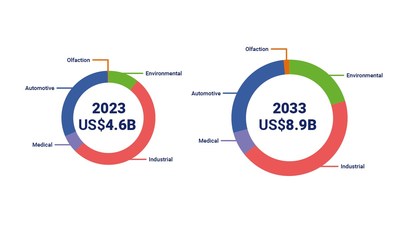BOSTON, Nov. 3, 2022 /PRNewswire/ —
Wood Burning: Cost-Effective but Toxic
Could gas sensors facilitate the safe use of wood-burning stoves to combat the energy crisis? With the cost of energy rising dramatically, interest in wood-burning stoves is growing as they become ‘more financially appealing than ever’. However, the impact of wood burning on air quality is also under the spotlight: it’s reported that even ‘eco-design’ stoves can emit more pollution than a truck. By continuously monitoring air quality, gas sensors enable wood-burning stoves to be used while minimizing the risk of toxic indoor air pollution.

Particulate Monitoring an Increasing Concern
Domestic gas sensors have long played a role within carbon monoxide alarms and even smoke detectors. Yet there are many more biproducts of wood-burning for us to worry about, including carbon dioxide, nitrogen dioxide and particulate matter.
Inhaling particulate matter is a topic of increasing concern due to its effect on our lungs, hearts, and nervous system. For example, recent regulations restricting the use of older diesel vehicles in urban areas are motivated by a desire to reduce particulate concentration. Whilst not strictly a gas, fine particles (formed via combustion) can be small enough to enter our lungs and even our bloodstream. It is thought this can increase the risk of blood clots and even heart attacks. When laws were introduced to prohibit smoking indoors, death from particulate matter exposure began to decline, yet wood burning indoors remains legal.
Optical Particle Counters for the Consumer Market
Wood burner use, alongside residents in urban areas, is now creating a domestic market for particulate matter detectors. Optical particle counters (OPC) use laser light which, when reflected off small particles, can be measured – with techniques available to count and size them. For both the industrial and environmental markets, these sensors allow users to feel safer. However, whilst for the industrial market, high sensitivity and robustness to extreme environments are key – for the mass-market connectivity and affordability are of higher value. Technological challenges continue to miniaturize OPCs further for integration into even more consumer devices, such as phones and wearables. This creates an opportunity for fundamentally smaller sensors, such as acoustic resonance or printed carbon-nanotubes which can also be used to detect particulate matter. Yet, for now, these sensor types remain much lower in technology readiness level. Instead, OEMs are choosing to integrate OPCs into air purifiers and other larger equipment. This has the added effect of adding value to users who also feel they are improving their air quality with access to real-time data.
Multiple Sensor Types Can Quantify Indoor Air Quality
More broadly, the demand for indoor air quality sensors to enable users to optimize for health against heating and ventilation needs is growing. IDTechEx forecasts that the total gas sensor market will expand to almost US$9 billion, with the market share for air quality and environmental monitoring doubling in the next ten years. There are many different gas sensor types competing for adoption in this space, as well as innovations from device makers to encourage us to use them. Technology of interest includes infra-red sensors, metal oxide semiconductors, electrochemical sensors, photo-acoustic sensors, and even carbon nanotubes. The devices within which they can be integrated range from a network of hubs spread throughout the home controlled via an app to sensors hidden with tables and even wearables. Infra-red sensors have been some of the most popular adopted so far as they compromise high sensitivity with ease of use as they are self-calibrating. Whilst the popularity of infra-red carbon dioxide sensors spiked during COVID for room occupancy monitoring, the long-term health effects of particulate matter are likely to see OPCs claim a greater share of the market going forward.
Outlook
Heating our homes is essential, and within the current economic climate, consumers are increasingly cautious about where to spend. However, the correlation between indoor air quality, wood burning, and pollution and the resulting cost for health could be better communicated. Marketing efforts toward those concerned about the impact of wood burning is just one strategy, but likely to be effective given the likely overlap of the existing smart-home market.
Gas sensor manufacturers and OEMs should offer solutions as opposed to just data. These systems need to stay affordable whilst maintaining the ability to meaningfully inform about pollutant levels and ideally close the loop by controlling heating and ventilation. The leading companies today are offering the detection of multiple pollutant types using lower-power sensors. Going forward, there is probably also scope for more modern business models – perhaps ‘air quality as a service’.
The IDTechEx report, “Gas Sensors 2022-2032: Technology, Opportunities, Players, and Forecasts“, outlines over ten different technologies across five key application areas. Opportunities and challenges for this sector – covering both indoor and outdoor air quality as well as automotive applications and digitized smell. This includes ten ten-year granular market forecasts, including 50 forecast lines and company profiles.
About IDTechEx
IDTechEx guides your strategic business decisions through its Research, Subscription and Consultancy products, helping you profit from emerging technologies. For more information, contact [email protected] or visit www.IDTechEx.com.
Images download:
https://www.dropbox.com/scl/fo/l4brn21r3p4tjdoinfwnz/h?dl=0&rlkey=8ctf4q8dx8066ugb6mg1rcjd7
Media Contact:
Lucy Rogers
Sales and Marketing Administrator
[email protected]
+44(0)1223 812300
Social Media Links:
Twitter: www.twitter.com/IDTechEx
LinkedIn: www.linkedin.com/company/IDTechEx
Facebook: www.facebook.com/IDTechExResearch

Photo: https://mma.prnewswire.com/media/1937361/IDTechEx_Gas_Sensor.jpg
Logo: https://mma.prnewswire.com/media/478371/IDTechEx_Logo.jpg
![]() View original content:https://www.prnewswire.co.uk/news-releases/how-gas-sensors-reduce-health-impacts-of-the-energy-crisis-301667500.html
View original content:https://www.prnewswire.co.uk/news-releases/how-gas-sensors-reduce-health-impacts-of-the-energy-crisis-301667500.html


